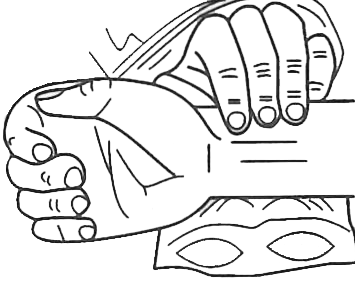
Fig. 7-1 Three sections of wrist pulse

Fig. 7-2 Finger positioning
Text
Pulse examination is done to examine the pulsation of blood vessels by feeling with the fingertips in order to make a diagnosis.
Pulse diagnosis is an important means of collecting clinical data from a patient. It is derived from the concept of holism — a part represents the whole.
There are several places you can use to take the pulse, such as carotid pulse* and anterior tibial pulse*. However, taking the wrist pulse* has proven to be the most convenient and most scientific. Wrist pulse refers to pulsation of the radial artery* on the wrist.
Wrist pulse is divided into three sections: cun, guan and chi (Fig. 7-1) or inch, bar and cubit. The bar /guan is central to the radial styloid* at the wrist where the tip of the physician's middle finger is placed; the inch /cun is next to the bar section on the distal side where the tip of the physician's index finger rests; and the cubit /chi is next to the bar section on the proximal side where the tip of the physician's ring finger is placed (Fig. 7-2).

Fig. 7-1 Three sections of wrist pulse |

Fig. 7-2 Finger positioning |
Because there are three sections at the wrist pulse, and each finger presses with light, moderate and heavy force, there are three depths (Fig. 7-3) to study the superficial, medium and deep pulses respectively. Theoretically, every depth indicates a condition of disease (for example, deep pulse indicates that the pathogen is in the interior); therefore, the wrist pulse is said to have three positions and nine indicators on each arm.

Fig. 7-3 Three depths of pulse
There are various opinions as to the three regions' corresponding organs. However, it is generally acknowledged that the descriptions in Huangdi's Internal Classic are the most accurate and widely followed. The three regions — inch, bar and cubit — of the left wrist reflect respectively the condition of the heart, the liver and the kidneys; and those on the right wrist reflect the condition of the lungs, the spleen and the life gate.*
When taking the pulse, bend your fingers and place the pads of the finger tips onto the patient's skin above the radial artery so that your fingers form a 45° angle with the surface of the patient's wrist.
You need to develop finger technique to examine the patient's pulse. Finger technique* refers to the finger manipulation used in pulse examination. The technique includes lifting*, pressing*, searching*, pressing with one finger* and simultaneous palpation*.
Lifting is for studying the superficial pulse with a light force. Pressing is for studying the deep pulse with a heavy force. Searching is for using a moderate force at first, and then changing the force by lifting and pressing and moving the fingers from left to right and from right to left to study the pulse. Pressing with one finger is for taking the pulse at each of the three sections individually. Simultaneous palpation is for taking the pulse of the three sections with the three fingers simultaneously.
The main factors that constitute the pulse can be generalized as position, rate, rhythm, shape, strength and smoothness of the pulse.